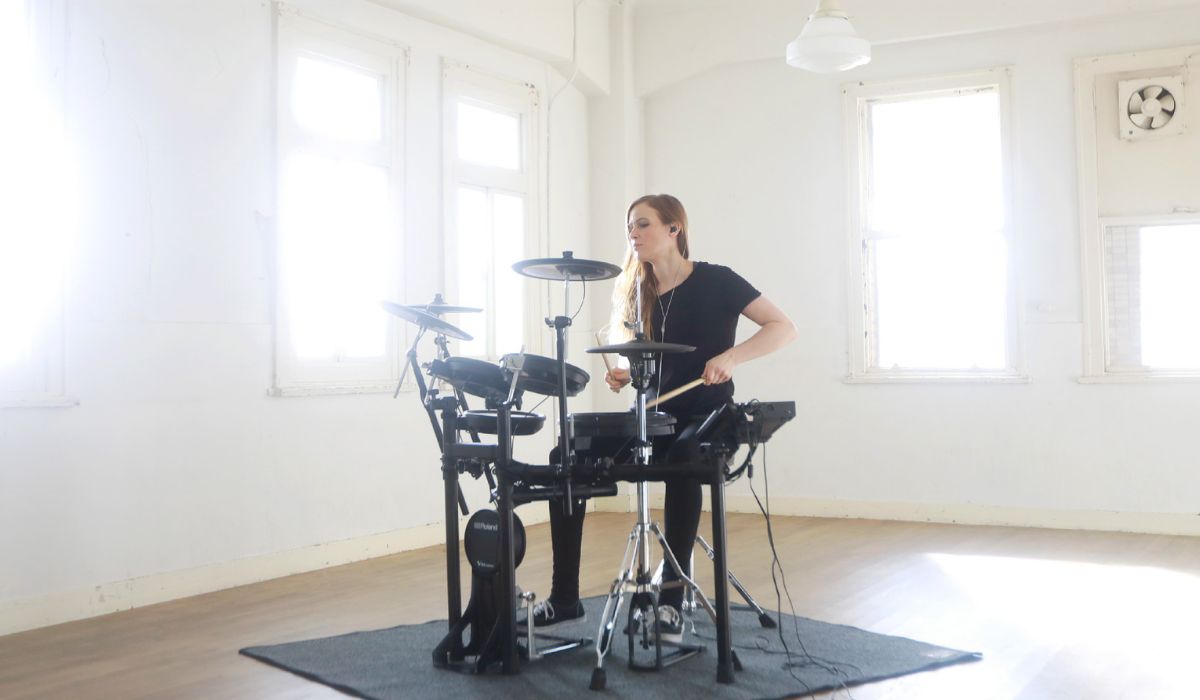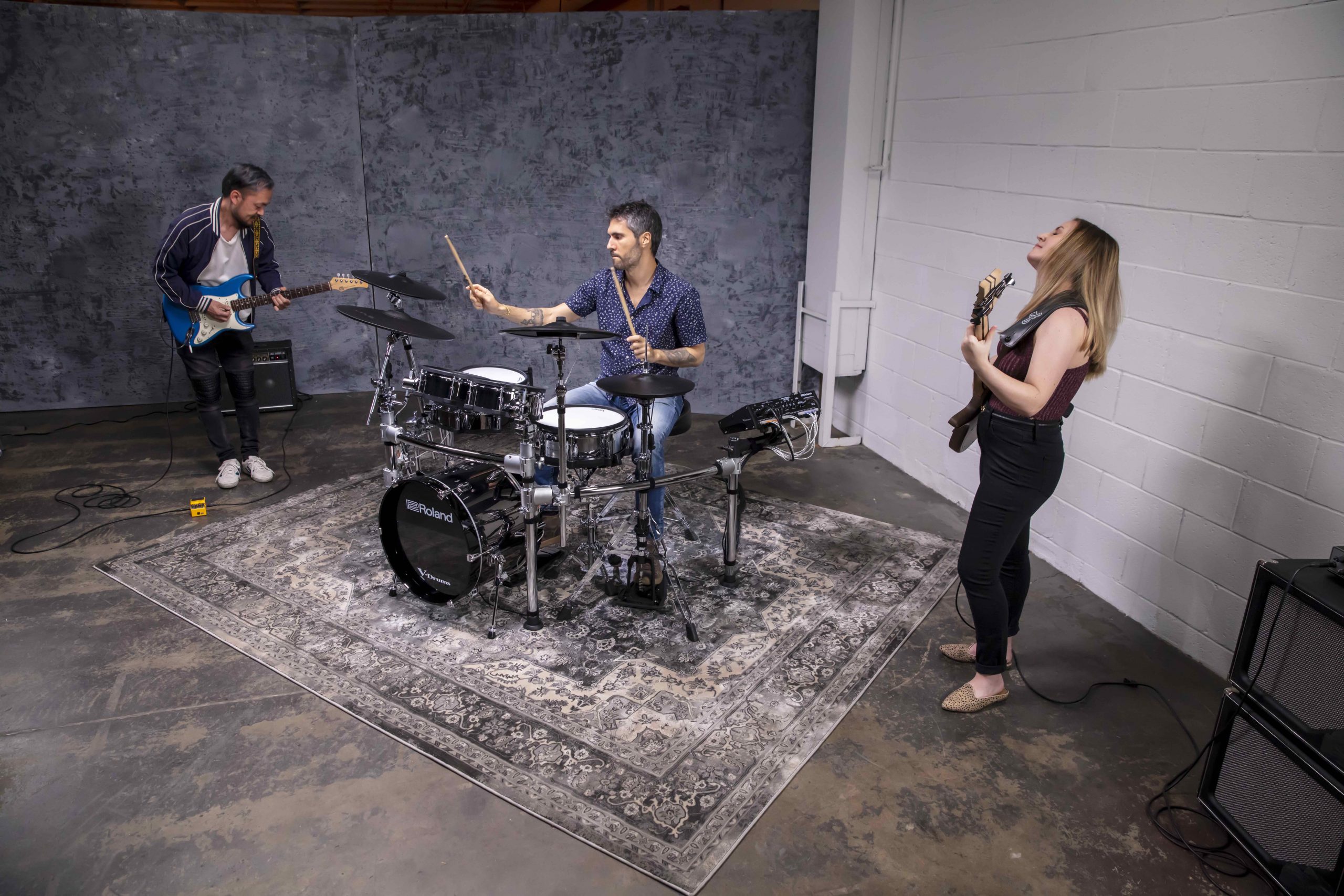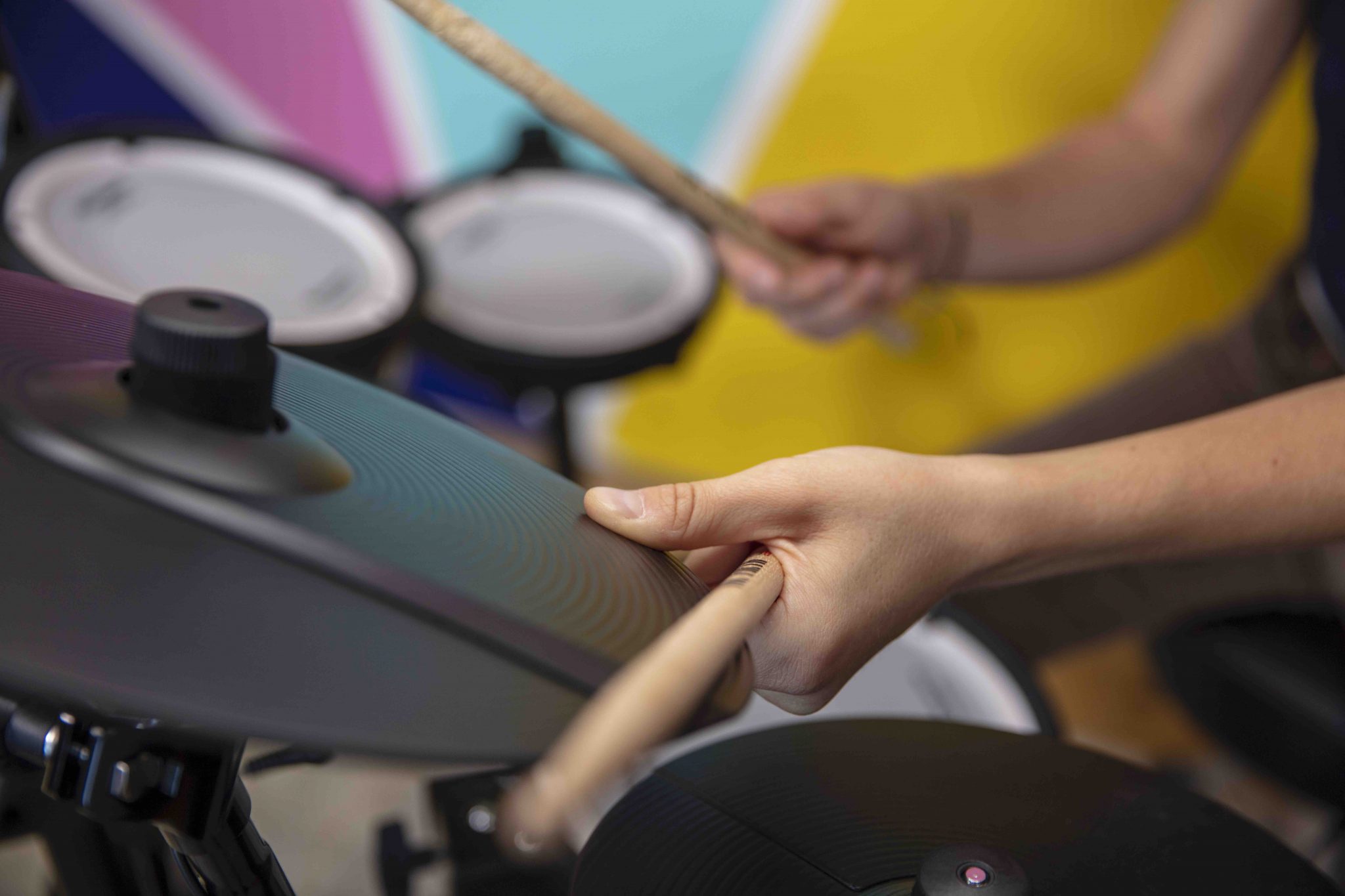Drumming combines brute force with sensitivity and steady rhythm with spontaneity. And when it comes down to it, learning to drum is an exercise in building patience. Don’t make the instrument more challenging with a giant drum set that’s hard to manage. Let’s see what types of drum sets are fun to play and which are simple enough for any beginner to use and maintain.
Bigger Isn’t Necessarily Better
Keep it manageable. Neil Peart’s Rush setups included up to two snares, nine toms, and many more cymbals. That’s too much for most drummers. When starting out, consider a four-piece kit with one bass drum, a snare drum, a rack tom, and a floor tom. Include one set of hi-hat cymbals, one crash, and one ride cymbal too. Drummers from The Beatles’ Ringo Starr to YouTube phenom Nandi Bushell enjoy smaller kits like this. It proves that big drums aren’t needed for a big sound.
Even with a smaller acoustic setup, little drums can still create a big, full sound. I’ve found that small jazz-style kits sound great for rock and modern music styles. Like their electronic drum set counterparts, they also take up less space at home. They’ll fit into bedrooms, garage studios, and basements. Small kits are much easier to haul around to rehearsals and gigs too. When looking at a compact beginner drum set, don’t write it off as cheap or too small. It’ll often still pack a punch. But while both small acoustic and all electronic drum kits are compact, what factors differ between the two?
"Electronic drums sound great every single time, and you never have to tune them."
Old School Cool Versus a Modern Marvel
For much of the twentieth century, learning drums meant using big, loud acoustic drums. With the advent of new technology in the 1970s and ’80s, electronic drums changed the game, and they’ve improved a lot since then. Today, drummers can use either type of drum to realize their musical vision. Acoustic drums remain tried and true, and modern technology makes electronic drums a great choice too. Both instruments produce inspiring sounds, but each has a distinct set of benefits.
Turn It Up or Keep It Quiet
Volume is one big consideration when looking at any type of drum set. Acoustic drums are loud. Drum mutes can dampen the snare, toms, and cymbals. Yet, this will often be loud enough to bother apartment neighbors. New quiet mesh replacement drumheads and low-volume cymbals just add unneeded costs to get up and running as a drummer.
Electronic drum sets only produce nominal noise. Get realistic sound solely going into headphones. The only thing other people will hear are soft taps and thuds. Keep parents, roommates, and neighbors happy with this quiet solution. The drummer stays happy too, enjoying big acoustic and electronic drum sounds like Tony Royster Jr. and Thomas Lang.
Skip the Tedious Tuning
A big challenge with acoustic drums is learning to keep them in tune. There are free lessons on how to tune drums online. Yet, it can still be a pain to maintain a good drum sound (even for the pros). Electronic sets sound great every single time, and this type of drum doesn’t need tuning. Sound modules, the brains of an electronic drum set, allow drummers to tweak tones, pitches, and effects as well. Get a great sound out of the box and craft a personalized tone over time.
"Learning with an acoustic set means going elsewhere for an education. An electronic set comes with integrated tools and helpful technology."
Make Learning Easy and Economical
Learning with an acoustic set means going elsewhere for an education. Learning with an electronic set comes with integrated tools and helpful technology. On an acoustic set, watch videos on a smartphone or tablet and play along. Acoustic kits pair well with a separate metronome to keep a consistent tempo.

Electronic drums centralize all the features above and give you more. The metronome is built into electronic drums. Easily stream music over Bluetooth too. Balance the levels between the drums and the music, and you’ll hear what you’re playing better. Correct mistakes that might get lost in the minutia of loud acoustic drums matched with a pair of earbuds.
Roland even offers in-depth learning applications on some models. The TD-07 offers an Onboard Coach that helps build better timekeeping at any tempo. For more info on teaching tools built into Roland drums, check out this article. You can even pair Roland drum sets with free Melodics learning software for real-time feedback on your playing. It’s impossible to get that kind of feedback from an acoustic kit without paying an in-person instructor to be there.
"Electronic drum kits with mesh heads closely match the conventional acoustic drum feeling. The detailed sound via headphones provides similar feedback to acoustic drums too."
Feeling and Feedback
I love the feeling of hitting acoustic drums. This type of drum provides immediate feedback on performance dynamics and tonality. Electronic drum kits with mesh heads closely match the conventional acoustic drum feeling. Note that not all mesh heads are created equally, though.
Today’s electronic kits sound great too. Detailed drum tones heard via headphones provide similar feedback to acoustic drums too. While acoustic drums might have a slight edge in feel, the sensation delivered by Roland mesh heads today is great.
Making Space
When considering the footprint of a drum set, it’s likely a toss-up. Compact acoustic drum sets and most electronic kits fit into corners, bedrooms, and basements. Going electronic will often reduce the number of stands needed, though.

Acoustic drum sets often need stands for every cymbal and most drums which makes setting the kit up a little tricky. It also makes moving the drums tricky. The bulk of electronic Roland V-Drums sits on one stand. This feature makes transport from one space to another a breeze.
Performance On the Gig
It takes time before beginners start to perform with other musicians. But if they’re bold enough to venture out quickly, an acoustic kit is self-contained. It takes time to pack everything into the car, but when it’s set up again, it’s ready to go.
An electronic set is easier to break down and transport. Once set up with the band, simply plug into amplification. Use a powered speaker or the band’s PA to make the drums loud enough for the band to hear. Many concert venues already have a PA. However, if a powered speaker is a necessary purchase for you, there are benefits beyond mere convenience. Control volume, tone, and effects right on the kit. Make the drums sound just like they would on a hit record.
"Electronic drums have the features new drummers need."
Decision Time
When it comes to choosing the right drum set, there’s a lot to consider. But after purchasing the perfect kit, it’ll inspire drumming and creative fun for years to come. Acoustic drums are an excellent choice for learning to tune and use conventional drums.
Electronic drums have the features new drummers need. Volume is adjustable for the drummer, and they’re always quiet for everyone else nearby. There are no tuning hassles with an electronic kit, and it’s easy to dial in personalized sounds. One kit includes any and every drum sound imaginable. Get a metronome, song playback, and learning tools with most Roland V-Drums. Plus. today’s digital kits feel just about the same as playing an acoustic kit.
"The inspiration an electronic kit provides will guide any drummer throughout their music career."
Get a better platform for learning drums with an electronic drum set. That doesn’t even include all the built-in extras. Extra features will help any beginner drummer as they become an intermediate player. The inspiration that kit provides will guide the drummer through their music career. Whether the goal is to play with the school jazz band or to rock the stage at a music festival, it can all start right here.







